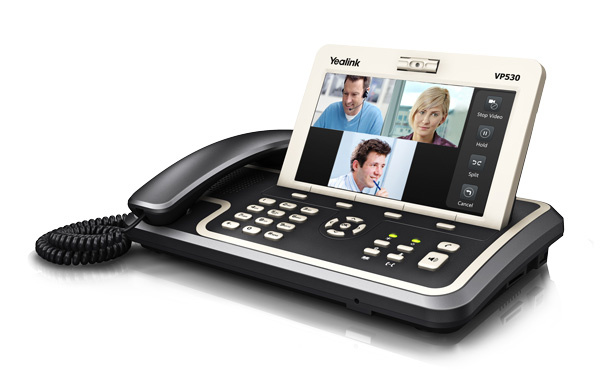The Yealink VP530 is the latest addition to Yealink’s line of what they’re calling, “executive-level IP Video Phones”. Obviously targeting executives and upper management, the online phone description touts ease of use, productivity, and a high degree of customization.

It’s an impressive looking phone with a 7” 800×480 digital LCD, touchscreen in addition to a full-featured keypad. I didn’t test the phone’s video capability but the screen offers a whole lot more functionality than just seeing who you’re talking to. This video goes into more feature detail.
High-level Features:
- TI DaVinci dual-core chipset, 2M CMOS camera
- 7” 800×480 digital LCD, 800×480 resolution touch screen
- HD Voice, full-duplex speakerphone
- 4 VoIP accounts, 3-way video conferencing
- BLF, Intercom, 18 one-touch soft DSS keys
- Open API
Audio Specifications:
- HD voice: HD codec, HD handset, HD speaker
- Wideband codec: G.722
- Narrowband codec: G.711(A/μ), G.723.1, G.729AB
- DTMF: In-band, Out-of-band(RFC 2833) and SIP INFO
- Full-duplex hands-free speakerphone with AEC
- Voice activity detection
- Comfort noise generation
- Adaptive jitter buffers
- Packet loss concealment
Physical Specifications:
- Rotatable CMOS sensor camera with 2M pixels
- 128MB flash and 256MB DDR2 memory
- 27 keys including 4 soft keys
- 6 feature keys: Mute/Camera/Phonebook/ Transfer/Redial/Hands-free
- 2xLEDs for power and status indication
- 2xRJ45 Ethernet 10/100M ports
- 1xUSB2.0 port, 1xSD card slot
- 2.5mm headset port
- Power adapter: AC 100~240V input and DC 5V/3A output
- Power over Ethernet (PoE) optional: IEEE 802.3af, Class 0
- Power consumption: 4~10W
- Net weight: 1.2Kg
- Dimension: 286x89x45mm
- Operating humidity: 10~95%
- Storage temperature: up to 60°C
Hardware [8/10]:
I give the phone high marks for hardware. Overall the phone feels really nice. It’s sturdy, the screen is clear and easy to read. It’s not as heavy as some snom or Polycom phones, but some people like that.
From a usability standpoint, the keypad buttons are well laid out. The buttons feel solid, but leave a bit to be desired when you depress them. The icons and screen interface are intuitive, and everything is easy to find.
Functionally, the touchscreen is responsive and snappy, and the menu layout makes sense and I was happy that there aren’t many layers to dig through to get to key functions.
I was a little annoyed that the camera on the phone is always on with a live feed of the camera output in one corner of the display. I don’t know about you, but I found my own ugly mug staring back at me all day from the side of my desk a little unsettling. Luckily the camera can be disabled entirely through the config interface, but a hardware on/off switch for the camera would have been appreciated.
Side note: In testing, it appears that the VP530 is using the same underlying SIP stack as all other Yealink phones, which can have some occasional stability issues. So while I didn’t encounter it in my testing, don’t be surprised if this device needs to be power-cycled every week or so, just like your trusty old Yealink T22P.
Sound Quality [7/10]:
I didn’t get to test the phone with a headset. The sound quality from the handset is really clear regardless of the codec. The speakerphone was about average and could fill up your personal office without a problem. It’s not ideal if you want to place in the middle of a conference table or have a bigger office. There isn’t any noticeable noise canceling on either the handset or speakerphone, so I wouldn’t use it in a noisy environment without a good noise-canceling headset.
SIP Compliance [6/10]:
My tests of the VP530 proved SIP RFC 3261 compliance. One major issue I ran into was when provisioning a non-Flowroute DID or adding multiple registrations. In both cases, the phone does not validate inbound RURI. Any INVITE sent rings all enabled lines. It’s something to be leery of if you’re connecting your phones directly to a SIP trunking provider without going through a PBX which is why I gave it a 6 in this category.
Conclusion [7/10]:
Pros:
|
Cons:
|
The VP530 is a nice phone that’s easy to use. It looks great and feels natural. The only issue is that it doesn’t fit well into situations where more than one direct line to your SIP trunk is required, but works like a champ with PBXs. If you’re looking for a modestly-priced executive phone with great features, look no further.
Yealink VP530
Reviewed by Justin Grow on
Jan 7
The Yealink VP530 looks impressive, and the touchscreen is sleek. Major issue: the VP530 doesn’t validate inbound RURI.
Rating:






